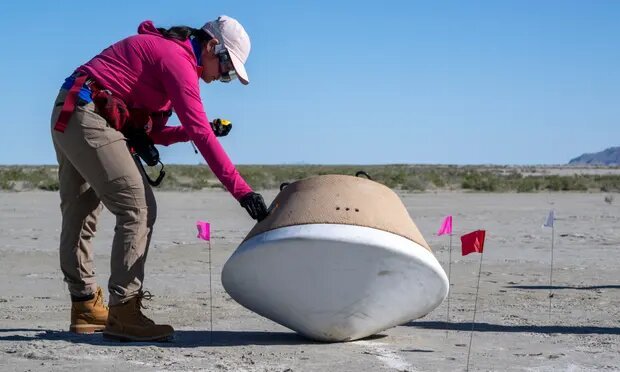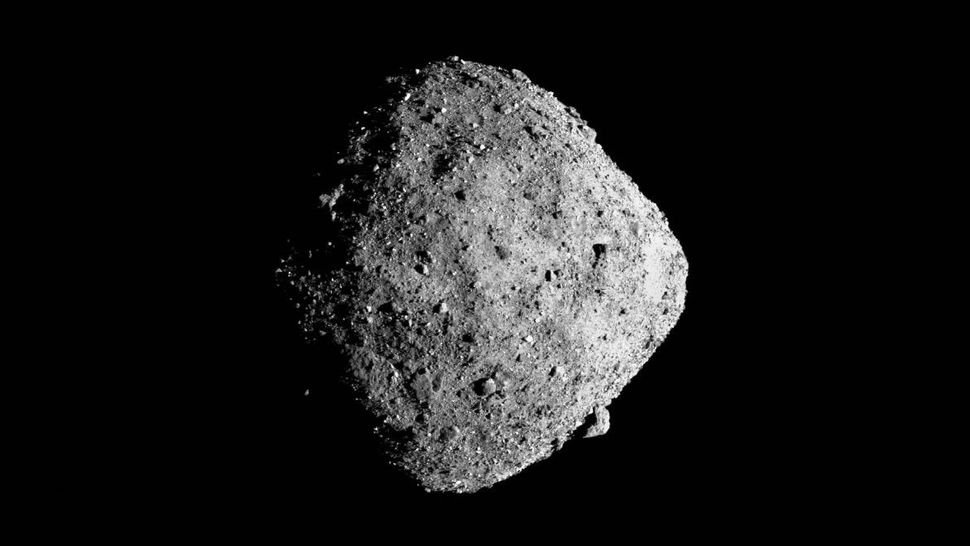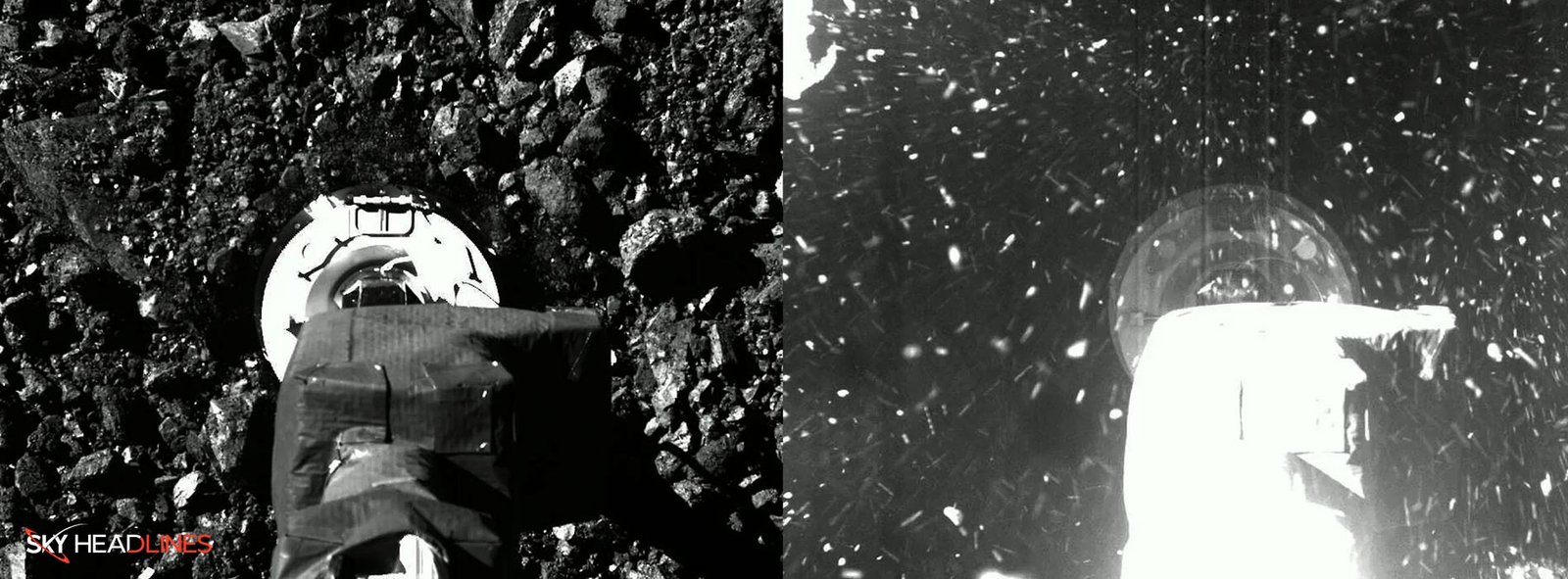NASA’s OSIRIS-REx is an ongoing mission that visited and collected a sample from asteroid 101955 Bennu, with the aim of returning the sample to Earth on Sept. 24, 2023.
What is so Exciting About the OSIRIS-REx Mission?
On Sunday morning, above the Utah desert, a parachute will deploy, gently lowering a capsule carrying approximately 250g of rubble to the ground. As it makes its descent, four helicopters, transporting scientists, engineers, and military safety personnel, will speed across the dry landscape to retrieve this valuable cargo.

This isn’t ordinary soil; it comprises chunks of space rock dating back 4.6 billion years. These fragments have the potential not only to provide insights into the formation of planets but also to offer clues about the origins of life itself.
Ashley King of the Natural History Museum (NHM) in London, says:
“These are some of the oldest materials formed in our solar system. Samples from asteroids [such as this] tell us what all those ingredients were for making a planet like the Earth and they also tell us what the recipe was – so how did those materials come together and start mixing together to end up with [habitable environments]?”
The final act of NASA’s Osiris-Rex mission may resemble the opening scene of an action movie, but it marks the culmination of a seven-year journey. During this, a robotic spacecraft, roughly the size of a transit van, was dispatched to investigate. And subsequently, gather resources from – the debris heap that forms the asteroid Bennu.

Diving Down Towards Earth & Details About Its Speed:
The capsule carrying this collection is anticipated to be released from the spacecraft at 06:42 AM EDT (11:42 AM BST) on Sunday. It will hurtle into Earth’s atmosphere four hours later at a speed of 27,650 miles per hour. As it descends towards Earth, its trajectory will be closely monitored, and parachutes will be deployed to gradually reduce its speed to around 11 miles per hour upon landing.
After the team retrieves the capsule, it will be placed in a sturdy metal crate, securely wrapped, and transported by helicopter to a temporary facility. By Monday, it will be swiftly transported to NASA’s Johnson Space Center in Houston.
While scientists assert that there is minimal risk of the samples posing a threat to Earth, they emphasize the importance of preventing any potential contamination in the opposite direction. To achieve this, filtered air will be permitted to flow into the capsule during its descent to Earth to prevent any potential leaks that might lead to contamination. Subsequently, the capsule will be connected to a stream of nitrogen.
One of the mission’s objectives is to gain a better understanding of how to predict and safeguard Earth from potential asteroid impacts. Analyzing the physical properties of the collected samples, such as their density and porosity, is expected to contribute significantly to this endeavor, according to King.

Spacecrafts Involved in the Examination of Asteroids:
The spacecraft was equipped with five instruments that conducted an exhaustive examination, mapping, and analysis of the asteroid, offering an unprecedented level of detail:
OSIRIS-REx Visible and Infrared Spectrometer (OVIRS) – OVIRS carried out its investigations by gauging visible and near-infrared light, with a specific focus on identifying organics and other mineral compositions.
OSIRIS-REx Thermal Emission Spectrometer (OTES) – OTES, using thermal infrared technology, determined Bennu’s temperature and produced maps detailing the distribution of minerals and chemicals. The collaborative efforts of OVIRS and OTES covered a spectrum of wavelengths to pinpoint the optimal location for collecting samples from the asteroid.
OSIRIS-REx Camera Suite (OCAMS) – OCAMS consisted of three cameras designed to map Bennu comprehensively. PolyCam, the largest of the cameras, captured the initial images of Bennu from a distance of 1.2 million miles (2 million kilometers) and also obtained high-resolution images of the chosen sample site. MapCam, on the other hand, scouted for satellites and dust plumes surrounding the asteroid, compiled colour maps of the asteroid’s surface, and took photographs essential for crafting topographic maps. SamCam documented the entire sample collection process, from its gathering to its secure capture.
OSIRIS-REx Laser Altimeter (OLA) – OLA meticulously scanned the entirety of Bennu’s surface, transmitting data that facilitated the creation of exceptionally precise 3D models of the asteroid’s surface. During the primary mission, one of the two Canadian-manufactured lasers ceased functioning, but it had exceeded its anticipated instrument lifespan and had successfully collected all the necessary data for OSIRIS-REx’s landing, as confirmed by investigators.
Regolith X-ray Imaging Spectrometer (RExIS) – RExIS concentrated on studying X-ray emissions emanating from Bennu, with the goal of generating a comprehensive map illustrating the distribution of various elements on the asteroid’s surface. Unlike other imaging tools, RExIS delved into the asteroid’s composition at the level of individual atomic elements.
Will OSIRIS-REx hit Earth?
The team operating the OSIRIS-REx spacecraft, an acronym representing Origins, Spectral Interpretation, Resource Identification, and Security-Regolith Explorer, has recently released fresh data. According to this data, there is an extremely low probability, specifically a one-in-2,700 chance, that the asteroid could collide with our planet. This potential impact event is estimated to occur nearly 159 years from now, specifically on September 24, 2182.
What did this mission discover?
The OSIRIS-REx mission journeyed to Bennu, an asteroid abundant in carbon, preserving the ancient history of our Solar System. This mission’s goal is to retrieve a portion of Bennu and return it to Earth. Bennu is believed to hold potential molecular building blocks that could shed light on the origins of life and even the formation of Earth’s oceans.
What is OSIRIS-REx and why is it important?
Indeed, OSIRIS-REx stands for “Origins, Spectral Interpretation, Resource Identification, Security-Regolith Explorer.” The primary objective of this mission is to acquire a sample weighing a minimum of 2.1 ounces (59.5 grams) from the near-Earth asteroid 101955 Bennu, previously identified as 1999 RQ36, and subsequently transport this sample back to Earth.
Did OSIRIS-REx return?
On September 24, 2023, NASA’s OSIRIS-REx mission will achieve a historic milestone by bringing back samples from the asteroid Bennu to Earth following seven years in the depths of space. This mission, initiated in 2016, successfully reached the asteroid Bennu in October 2020 and obtained samples from the surface of this near-Earth asteroid.
What is this mission powered by?
OSIRIS-REx is equipped with two solar panels attached to the zenith panel of the spacecraft, which serve as power generators. When unfurled, these solar arrays provide the spacecraft with an impressive wingspan of 6.2 meters, covering a total active area of 8.5 square meters.
Who built OSIRIS-REx?
The spacecraft for the OSIRIS-REx mission is being constructed by Lockheed Martin Space Systems in Denver. This mission represents the third instalment in NASA’s New Frontiers Program. Oversight and management of the New Frontiers Program on behalf of NASA’s Science Mission Directorate in Washington are handled by NASA’s Marshall Space Flight Center, situated in Huntsville, Alabama.
How does this mission communicate with Earth?
The OSIRIS-REx spacecraft is equipped with a high-gain antenna located on its sun-facing side, which facilitates communication with Earth. On the opposite side of the spacecraft is the TAGSAM, short for Touch-And-Go Sample Acquisition Mechanism. TAGSAM is a 3.4-meter-long, folding arm designed to extend. And collect a sample from the mission’s target, the near-Earth asteroid Bennu.





